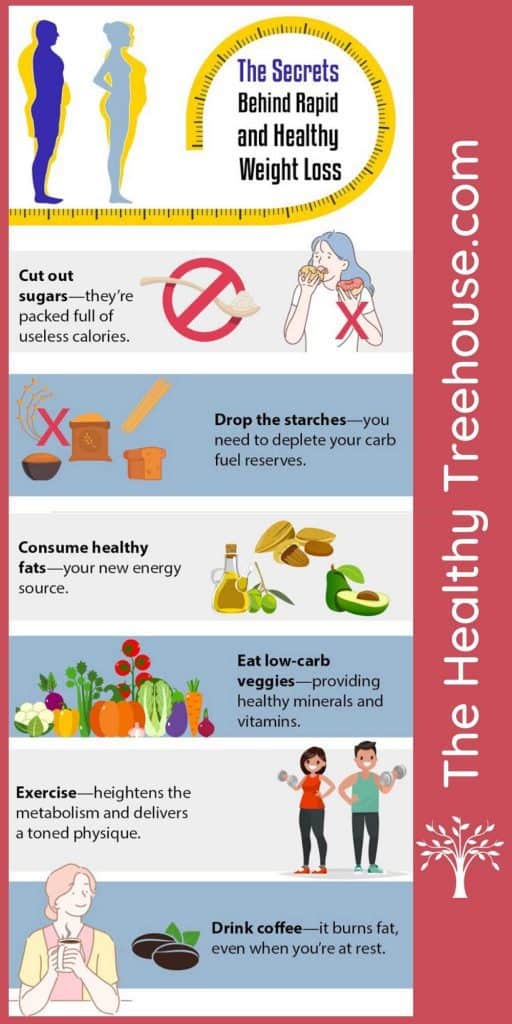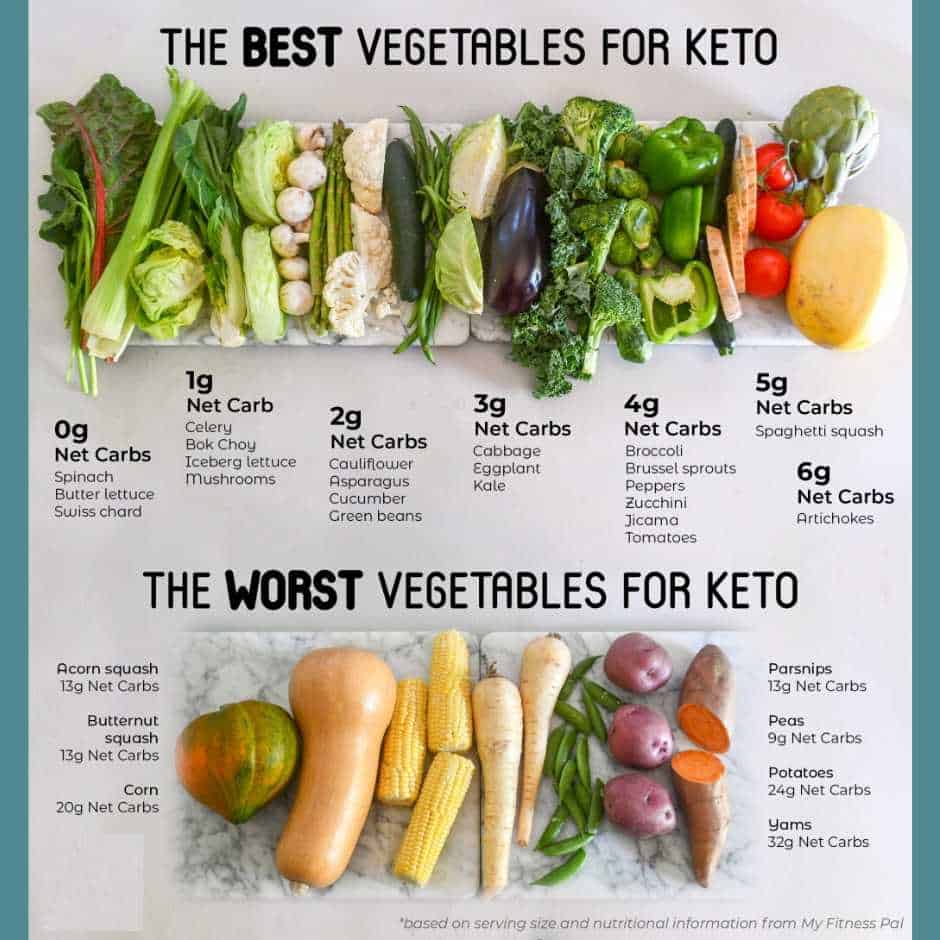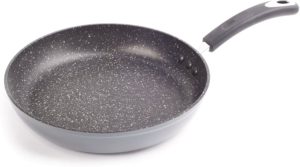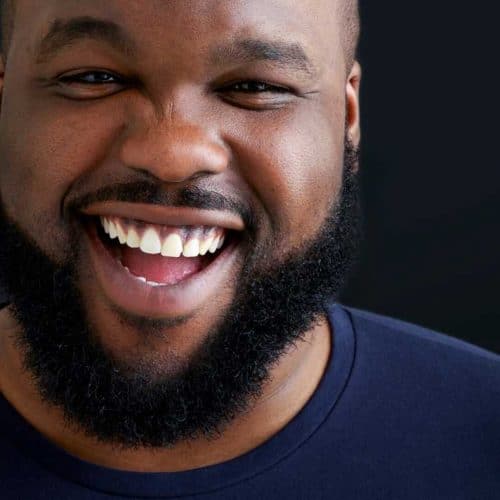I used to be fit. Not cut. But, healthy. Then I became a parent. Who has time to work out when your are working full time and have kids? My growing “dad bod” was on my radar, but I was not too concerned… then my daughter said I looked like Santa. I decided it was time to take action.
I knew myself, though, that finding the motivation to stick with it would be a factor. If I wanted to get fit and stay fit, then I needed to be motivated. I would need to know how to lose weight fast, so I did my research. And, I found a surprisingly simple way to see results that lasted — quickly.
I wasn’t happy with the way I looked, but more importantly I was worried about my long-term wellbeing. I wanted to be able to keep up with my kids; enjoy weekend bike rides; be a healthy role model for them.
So, a few small diet adjustments—moderate exercise—and I made remarkable headway.
The Simple Way to Lose the Belly Barrel
- Ditch the starchy carbs
- Cut out sugars
- Eat plenty of protein
- Fill my plate with low-fat vegetables
- Exercise
What should you notice about this list? That it is mainly about your diet.

The Weight Shedding Problem
In the US, 34 percent of adults and 20 percent of children are obese. Excess consumption of ready-made foods, stress-induced overeating and a lack of exercise take their toll.
But, eating sensibly and keeping active is more a mental barrier than a time or money restraint. If you want to make a change, you can!
Healthy people are happier. More energy and a positive outlook allows us and our children to engage in the wide and wonderful world out there. As stated in a study published in the Canadian Medical Association Journal, “The unhappiest people were about 80 percent more likely to develop impairments in daily functions, compared with the happiest.”
Shared family experiences are priceless: being out for a hike, cycling in the countryside, or playing sports.
And, it’s your responsibility to set a good example.
Studies demonstrate that children mimic the eating habits of their parents—if you eat responsibly, so will they. Furthermore, childhood meal behavior influences their adult food choices.
So, teach them well now, and they have that ethos for life.
Don’t fall into the trap of thinking this means cutting back on calories, especially where kids are concerned. This can leave you feeling hungry, depressed, and agitated.
Furthermore, scientists explain that consuming fewer calories can have the opposite effect. The body’s metabolism, believing it’s beginning to starve, slows down.
It doesn’t have to be this way!
The Best Way to Lose Weight Fast

Fast weight loss isn’t just a pipe dream.
Backed by peer-reviewed research, there’s a way of dropping the fat from your body without consuming fewer calories, using diuretics to reduce water weight, or taking a pill once per day.
This three-step method will:
- Dramatically reduce your appetite
- Elevate physical and mental health
- Ensure you achieve your desired weight quickly and safely
All of this without eating fewer calories.
How to Lose Weight the Fastest — the Three-Step Plan
Before we start, some quick advice.
Losing weight through this method isn’t difficult, but you must follow every step. I like to think of it as making a BLT sandwich—lose the bacon, lettuce or tomato—and it’s just, well, boring… it doesn’t work.
And, here is the part that is so very hard for me: be consistent! I am the king of stopping and starting.
When I started this plan, I saw rapid results, then returned to my old ways. Unsurprisingly, the weight came back. This is a lifestyle change. Not a one and done.
Once you’ve achieved your desired result, you will need to find the right balance of your new lifestyle and the prior one. It’s kind of life floating on a blow up raft. Too much air and you’re not comfortable or you might explode. Too little air and you sink. Just the right amount is…. perfection!
Step 1—Cut Back on the Bad Sugars and Starches
Just like a car, your body requires fuel. It’s what powers your movement, metabolic function, and thinking. Instead of gasoline, your fuel reserves are the foods you eat every day.
But one macronutrient, in particular, is your body’s trusted source, the carbohydrates you ingest. That is, the sugars and starches in your diet.
Some quick science.
When you eat carbohydrate-rich foods, your liver converts them into glycogen. This becomes the fuel tank and is drawn on whenever you need an energy boost.
Here’s the key for rapidly shedding weight, deprive your body of this theoretical gasoline.
And, like forgetting to visit the gas station, your fuel tank will rapidly drain until it’s virtually empty. Your metabolism then enters survival mode. It requires energy to keep you alive, so it asks the liver for help.
Willing to please, your liver goes and seeks out your fat stores. It turns fat into water-soluble molecules, known as ketones and fatty acids. Your body can now burn them for energy.
The bottom line, you drop the fat and the excess pounds.
It’s not just one of the best ways to lose weight because it reduces fat, it also boosts weight loss by:
- Preventing overeating—low carb diets inhibit ghrelin production, a hormone that tells you that you’re hungry
- Consuming fewer carbohydrates means an increase in urination, helping you shed excess water weight
- Fewer carbs mean you’re omitting many drinks and foods, which include the weight-gaining simple sugars
I shed around 10 pounds in the first week and the typical person drops nearly 4.5 pounds more over a year than those following a low-fat diet.
The key foods to dramatically cut back on are:
- Fruit—they contain the sugar fructose—although you can treat yourself to a few berries and a fat-rich avocado
- Legumes, lentils, and beans—high in carbs, so no chickpeas, kidney beans or fava beans
- High-starch vegetables—potatoes, carrots, parsnips, turnips and yams
- Simple sugar drinks and foods—drop the fruit juice, sodas, ice cream, sweets, cakes and cookies
Step 2—Eat Fat, Protein and Low-Carb Veggies
The beauty of this plan is that your meals are never dull.
You should consume one fat source, one protein source and some low-carb vegetables per meal per day.
Don’t worry about your calories, they’ll take care of themselves.
Fat
That’s right, I’m telling you to eat fat.
Let’s be honest, fats taste darn good. That’s why in so many other diet plans, they can be your downfall. In this low-carb program, fats are perfectly fine.
Yet, that doesn’t mean a free-for-all. You need to eat the right fats.
Choose foods, or dressings, that are either unsaturated or contain medium-chain triglycerides. These are compounds that assist with weight loss.
Ideal examples of these fats include:
- Coconut oil
- Butter
- Avocado oil
- Virgin olive oil
- Oily fish—such as sustainable tuna, trout, mackerel, salmon and sardines
- Cheese—although avoid processed varieties as they can contain sugar
- Dairy
- Nuts and seeds
Be warned, some fats are definite no-nos.
Completely avoid hydrogenated oils and trans fats. These nasty over-processed products are packed with unnecessary and pointless calories—and can cause heart disease and obesity.
That means steering clear of:
- Margarine
- Sunflower oil
- Cottonseed
- Processed foods
- Chips
Protein
While fat takes care of your energy, protein becomes your pound-shedding partner.
Ok, it fulfills many crucial physiological functions such as building muscle, repairing tissues, creating hormones, and strengthening bones.
Yet, as a fat-dropping aid—it’s indispensable.
Research explains that eating a diet high in protein can:
- Elevate the rate of weight loss
- Promote a feeling of satiety—if you feel full, you’re unlikely to consume excess calories
- Boost the metabolism—meaning you burn more calories and hence drop pounds
- Increase urination frequency—helping you to lose the bloating associated with excess water weight
Foods to eat per day for your protein intake include:
- Fresh meat—virtually no meat is excluded (except processed) Whatever you fancy—beef, veal, lamb, chicken or turkey—or even the more exotic kangaroo or ostrich
- Oily fish—not only ideal for your protein, but you’re also addressing the fat requirement your body needs
- Free-range eggs—scramble, fry or boil
- Dairy—high in fat and protein—so milk, cream, butter and yogurt
On that last point, if you enjoy yogurt, make sure you’re only consuming unsweetened, unflavored or those without fruit. Otherwise, you’re sticking unnecessary sugars and calories into your body.
Low-Carb Vegetables
Your diet isn’t going to be completely carb free.
The target is to consume no more than 20-50 grams per day. You and I know that calculating food intake isn’t easy or fun. None of us have time for charts, calculators, and scales.
So, I’ll make it simple.
You can eat vegetables—as long as they’re low in carbs. Hence, I’ve put together a list below of the ideal veggies for your daily meals. They’re so low in sugars and starches you can virtually load your plate with them, without being concerned about breaking your carb fast.
Here’s what I like;
- Spinach
- Peppers
- Cauliflower
- Onions
- Kale
- Cabbage
- Lettuce
- Cucumber

Step 3—Exercise
You knew it was coming, right?
Don’t worry, you don’t have to become an utter cardio freak for this weight-loss plan to work.
In fact, if you follow the above diet regimen—you should still drop weight. But, we’re talking about how to lose weight quickly—and that involves some exercise.
Ideally, you will lift weights.
You can join a gym and take advantage of their extensive facilities. But, if time, location, or cost are preventative, there’s nothing stopping you from working out with some dumbbells or taking advantage of a bench at home.
You’re thinking—why lift iron? Can’t I just go for a run?
The truth is, you can, but for this diet, pumping the muscles is more beneficial.
High-intensity and endurance cardio exercise requires having an immediate and long-lasting energy source. And, that comes from carbs. You’ve probably heard of marathon runners pre-loading on pasta before a big race—and that’s why.
But the energy from fat isn’t as rapid so you need a less intense exercise—weight lifting.
Research shows that resistance training promotes weight loss and builds and defines muscles, even while on a low-carb program.
Conversely, if hitting the dumbbells really isn’t for you—by all means run, cycle, or swim—just don’t go for extended endurance.
The Cyclical Low-Carb Diet
Some athletes follow a cyclical carb diet. During one week, they will stick to the above plan for five or six days that they follow with one or two days of upping their carb consumption.
This enables them to lose fat and gain lean muscle, while having sufficient reserves for high-level sporting performance.
And, you can do it too.
Be careful. If you want to lose weight rapidly, I’d make sure that you don’t have more than one “cheat” day per week.
There’s some evidence that this short-term carbohydrate intake can boost the fat-burning hormone leptin. It’s possible you may notice a little increase on the scales after these “sin” days—although this is most likely due to an elevation in water weight, which you’ll drop again over the next 48 hours.
Improving Your Health
One of the main concerns about diet plans is that they may not always be great for your wellbeing.
Admittedly, dropping the pounds is an excellent way to boost health. Unfortunately, some fat-busting programs can exclude vital vitamins and minerals, or deliver too few calories for your body to function correctly.
This three-step program isn’t like that.
You’re still eating meat and vegetables, therefore providing virtually all the nutrients you require. What’s more, as you’re not counting calories, you’re not going to be hungry or lack the energy to cope with day-to-day activities.
Furthermore, a low-carb diet has the benefits of:
- Reducing obesity—lowering the risk of heart disease, cancer and diabetes
- Improving skin—simple sugars cause acne and spots
- Inhibiting the symptoms of Parkinson’s disease
- Providing an effective treatment against epilepsy
- Lowering blood pressure
- Decreasing blood sugar levels—helping those with Type 2 diabetes
What About the Children?
You don’t want to be making one meal for you and different plates for your kids.
I know, it’s a hassle, and you lack the time.
Luckily, you don’t have to.
Scientists from the University of Colorado explain that a high-protein, low-carb diet is perfectly safe for children, for either maintaining a healthy weight or for fat reduction.
The benefits for the kids include:
- Lowering sugar intake to prevent tooth decay
- Reducing the chance of developing diabetes
- Elevating concentration
- Eliminating sugar rushes that leads to calmer kids
- Omega-3 oils in fish that promote healthy brain and eye development
What’s more, feeding a picky child is easy on this program. Their choice of foods are varied and contain fat, and kids love the taste of fat. Our keto meal planning for families can help you start.
How Fast Will I Lose Weight?
I’ll be honest with you, it depends.
Factors that can affect the rate when you start to lose the flab include:
- Age
- Gender
- Metabolic rate
- Current level of carbohydrate intake
- Exercise levels
- Existing height and build
We’re all different, and this determines the speed of pound dropping.
That said, typically, the process works as follows:
In the first one to two days, you’ll probably see little change. But don’t become discouraged! Your body is using up its carb stores, so stick with it.
Over the next few days to a week, you’ll begin to see a noticeable difference, often in the region of 5-10 pounds in seven days. Then, the drop should plateau out, delivering a steady decrease as every week passes.
Just a quick heads up.
This plan may induce a keto or low-carb flu. Symptoms are:
- Halitosis
- Constipation or diarrhea
- Headache
- Diarrhea
- Lethargy
- Muscle cramps
Don’t worry, see it through. It’s just your body adjusting to the new energy reserves after a lifetime of relying on carbs. Within three to four days, these unwanted effects will dissipate.

Five Top Fat-Busting Tips
To really take your weight loss to the max, combine these tips with your diet:
- Enjoy a rewarding sleep—those who experience interrupted or short sleep are more likely to put on the pounds
- Incorporate a protein-rich start to the day—it reduces food cravings as the day progresses
- Have a glass of water before dinner—studies show it promotes weight loss
- Ditch the sodas—they’re packed with flab-fueling sugar
- Drink coffee—it elevates the metabolic rate, burning calories.
How to Lose Fast Weight FAQs
How Can I Drop 20 Pounds in a Week?
Following the above plan, in one week, many people drop around ten pounds. Some a little more, some less.
Twenty pounds in a week would be surprising. Stick to it, and you’ll rapidly reach your target.
Can You Lose 7 Pounds in 3 Days?
It’s possible.
During the first few days of this program, your body will still have carbohydrate (in the form of glycogen) stores. Once you’ve depleted these reserves, you’ll then notice the pounds start falling off.
Hence, it’s better to look at flab-fighting over a one week period—rather than a few days.
How Can I Lose Weight Overnight?
A high-protein diet and lifting iron boost your resting metabolic rate; that is, the number of calories that you burn while at rest.
Hence, even while sleeping, your body is using elevated levels of energy, promoting fat reduction.
Do I Need to Count Calories?
As long as you consume healthy fatty foods, have a high protein intake, and eat veggies low in carbs—there’s no reason to count calories.
But if you’re more comfortable including this method with your diet plan, here’s a handy calculator.
Where Do You Lose Fat First?
That’s unfortunately your body’s decision, not yours!
Your physical shape, metabolism, sex, and genetics can all affect where the pounds initially disappear. So, if your aim is to lose the belly, but it’s coming off your butt, stick with it!
Furthermore, don’t think that concentrated exercise will have any effect. Doing an insane level of squats will undoubtedly build leg muscle—but it’s as likely to shed flab from your arms than it is your thighs.
Why am I not losing weight on keto intermittent fasting?
I have to admit that the first time I tried keto dieting, I did not lose a single pound. More accurately stated, I gained back all the weight that I lost. I re-evaluated what I was doing and realized that the primary cause was my diet. I was simply eating too many carbs, not eating the correct healthy foods, eating too many calories, and constantly snacking.
The solution was to plan what I was going to eat. I know this sounds simple, and it was, but it took some time to figure it out. In this article, we explain how to manage your diet by creating a meal plan that will work for you and your family.
Can I eat as much as I want on keto?
Wouldn’t this be great! But, no, you can’t. If you eat a wheelbarrow full of avocados, then you are not going to lose weight (and experience some other… interesting moments).
The good news is that you will not be hungry after a few days if you are eating correctly. If you feel hungry for more than a few days, then you are probably not eating enough fiber or sleeping enough.
Our 7-day meal planning guide for you and your family will get you started.
Summary
Losing weight doesn’t have to be painful!
Follow this high-protein and low-carb plan—and you and your family can enjoy every meal while remaining slim, toned and healthy.
No calorie counting, impossible exercises, or starving yourself.
Just tasty and nutritious foods that will leave you feeling amazing!



